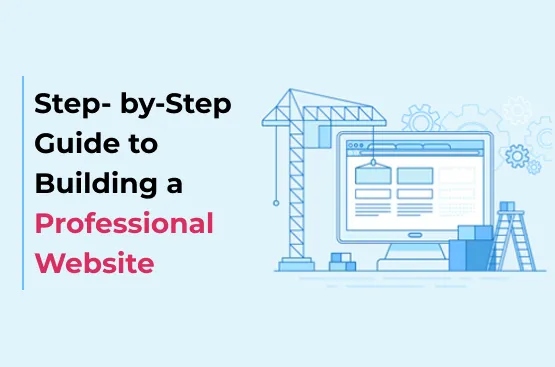
A professional website is essential for any business, personal brand, or online venture. Whether you’re a freelancer, entrepreneur, or small business owner, having a well-designed website helps establish credibility, attract customers, and grow your brand.
If you’re wondering how to build a website from scratch, this step-by-step guide will walk you through the process, from planning to launching your site.
Step 1: Define Your Website Goals
Before diving into website creation, it’s important to define your goals. Ask yourself:
✅ What is the purpose of your website? (e.g., portfolio, e-commerce, blog, service-based business)
✅ Who is your target audience?
✅ What key features do you need? (e.g., contact form, booking system, e-commerce store)
✅ What is your budget and timeline?
Clearly outlining your goals will help you choose the right tools and design for your website.
Step 2: Choose the Right Website Platform
There are several platforms available for building a website, and choosing the right one depends on your needs.
Popular Website Builders & CMS:
✔ WordPress.org – Best for blogs, business websites, and e-commerce (requires hosting).
✔ Wix – Easy-to-use drag-and-drop builder for beginners.
✔ Shopify – Best for e-commerce stores.
✔ Squarespace – Great for visually appealing websites.
✔ Webflow – Ideal for advanced users who need full design control.
For maximum flexibility and customization, WordPress is the most recommended option.
Step 4: Install WordPress & Choose a Theme
If you choose WordPress as your platform, follow these steps:
1️⃣ Install WordPress – Most hosting providers offer a one-click installation.
2️⃣ Select a Theme – Pick a professional theme from the WordPress repository or premium providers like Astra, GeneratePress, or Divi.
3️⃣ Customize Your Theme – Use the WordPress Customizer or page builders like Elementor or WPBakery to design your site.
A well-structured theme makes your website look polished and user-friendly.
Step 5: Install Essential Plugins
Plugins enhance your website’s functionality. Here are some must-have WordPress plugins:
✅ SEO Optimization – Yoast SEO or Rank Math
✅ Security – Wordfence or Sucuri
✅ Speed Optimization – WP Rocket or LiteSpeed Cache
✅ Contact Forms – WPForms or Contact Form 7
✅ E-commerce – WooCommerce (for online stores)
✅ Analytics – Google Site Kit or MonsterInsights
Install and configure plugins based on your website’s needs.
Step 6: Create Essential Pages
Your website should have the following key pages:
✔ Home Page – A compelling introduction to your business.
✔ About Us – Share your story, mission, and values.
✔ Services / Products – Showcase what you offer.
✔ Blog (Optional) – Share industry insights and attract visitors.
✔ Contact Page – Add a contact form, email, and phone number.
✔ Privacy Policy & Terms – Required for legal compliance.
Use high-quality images, well-structured content, and a clear call-to-action (CTA) on each page.
Step 7: Optimize for SEO & Mobile-Friendliness
To rank higher in search engines and attract more visitors, optimize your website with these SEO best practices:
🔍 Use SEO-friendly URLs – (e.g., yourwebsite.com/services instead of yourwebsite.com/page?id=123)
🔍 Optimize Images – Compress images with plugins like Smush or ShortPixel.
🔍 Use Keywords Naturally – Research relevant keywords and integrate them into your content.
🔍 Enable Mobile Responsiveness – Ensure your site looks great on all devices.
🔍 Improve Loading Speed – Use caching and a content delivery network (CDN).
Step 8: Test Your Website & Fix Issues
Before launching, test your website to ensure everything functions properly.
✅ Check for broken links.
✅ Ensure all forms and buttons work.
✅ Test on different browsers and mobile devices.
✅ Optimize loading speed using Google PageSpeed Insights.
Fix any errors to ensure a seamless user experience.
Step 9: Launch Your Website
Once everything is set up, it’s time to go live! 🎉
🔹 Announce Your Launch – Share your website on social media, email newsletters, and online directories.
🔹 Submit to Google – Use Google Search Console to index your site.
🔹 Monitor Performance – Track visitor traffic using Google Analytics.
Step 10: Maintain & Update Your Website Regularly
A website is not a one-time project; it requires regular maintenance to stay relevant and secure.
✔ Update WordPress, themes, and plugins regularly.
✔ Backup your website to prevent data loss.
✔ Add fresh content to keep visitors engaged.
✔ Monitor security to prevent hacks and malware attacks.
By maintaining your website, you ensure long-term success and credibility.
Final Thoughts
Building a professional website may seem challenging, but by following these steps, you can create an effective and high-performing site. Whether you’re a small business owner, freelancer, or entrepreneur, investing in a well-structured website will help you reach a wider audience and grow your brand.
🚀 Need help building a website? Contact us today, and let’s bring your vision to life!